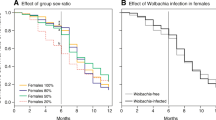Summary
Maternally inherited microorganisms that kill male (but not female) progeny are widespread in nature. Three hypotheses have been proposed for the evolution of male-killing microorganisms: inbreeding reduction, release of resources to remaining females and inoculum for horizontal transmission. The sonkiller bacterium,Arsenophonus nasoniae, is a maternally inherited bacterium that causes lethality of male embryos of infected females in the parasitoid wasp,Nasonia vitripennis. In this paper we describe the geographical distribution and frequency of the son-killer bacterium in North American populations ofN. vitripennis andNasonia longicornis. We tested the resource release hypothesis using the body size measurements of infected and uninfected females from natural populations. No evidence was found for a fitness increase of females infected with the bacterium compared to uninfected females. We propose a modification of the existing models, termed the ‘incremental gain’ hypothesis. According to this model, the bacteria are maintained in host populations due to horizontal transmission and male killing provides an incremental gain in the fitness of infected females relative to females infected with non-male-killing bacteria.
Similar content being viewed by others
References
Andreadis, T.G. (1990) Epizootiology ofAmblyospora connecticus (Microsporida) in field populations of the saltmarsh mosquito,Aedes cantator, and the cyclopoid copepod,Acanthocyclops vernalis.J. Protozool. 37, 174–82.
Beukeboom, L.W. and Werren, J.H. (1992) Population genetics of a parasitic chromosome: experimental analysis of PSR in subdivided populations.Evolution 46, 1257–68.
Charlesworth, D. and Ganders, F.R. (1979) The population genetics of gynodioecy with cytoplasmic-genic male sterility.Heredity 43, 213–18.
Darling, D.C. and Werren, J.H. (1990) Biosystematics ofNasonia (Hymenoptera: Pteromalidae): two new species reared from birds' nests in North America.Ann. Entomol. Soc. Am. 83, 352–70.
Ebbert, M.A. (1991) The interaction phenotype in theDrosophila willistoni—spiroplasma symbiosis.Evolution 45, 971–88.
Ebbert, M.A. (1993) Endosymbiotic sex ratio distorters in insects and mites. InEvolution and Diversity of Sex Ratio in Insects and Mites (D.L. Wrensch and M.A. Ebbert, eds), pp. 150–91. Chapman & Hall, New York.
Ebbert, M.A. (1995) Variable effects of crowding onDrosophila hosts of male-lethal and non-male-lethal spiroplasmas in laboratory populations.Heredity 74, 227–40.
Gherna, R.L., Werren, J.H., Weisburg, W., Cote, R., Woese, C.R., Mandelco, L. and Brenner, D.J. (1991)Arsenophonus nasoniae gen. nov., sp. nov., the causative agent of the son-killer trait in the parasitic waspNasonia vitripennis.Int. J. Syst. Bacteriol. 41, 563–5.
Huger, A.M., Skinner, S.W. and Werren, J.H. (1985) Bacterial infections associated with the son-killer trait in the parasitoid waspNasonia ( =Mormoniella)vitripennis.J. Invertebr. Pathol. 46, 272–80.
Hurst, G.D.D., Majerus, M.E.N. and Walker, L.E. (1992) Cytoplasmic male killing elements inAdalia bipunctata (Linnaeus) (Coleoptera: Coccinellidae).Heredity 69, 84–91.
Hurst, G.D.D., Majerus, M.E.N. and Walker, L.E. (1993) The importance of cytoplasmic male killing elements in natural populations of the two spot ladybird,Adalia bipunctata (Linnaeus) (Coleoptera: Coccinellidae).Biol. J. Linn. Soc. 49, 195–202.
Hurst, L.D. (1991) The incidences and evolution of cytoplasmic male killers.Proc. R. Soc. Lond. B 244, 91–9.
O'Neill, K.M. and Skinner, S.W. (1990) Ovarian egg size and number in relation to female size in five species of parasitoid wasps.J. Zool., Lond. 220, 115–22.
Saul, G.B., Saul, S.W. and Becker, S. (1967) Linkage inMormoniella.Genetics 57, 369–84.
Shull, A.F. (1948) An all-female strain of lady beetles with reversions to normal sex ratios.Am. Nat. 82, 241–51.
Skinner, S.W. (1983) Extrachromosomal sex ratio factors in the parasitoid wasp,Nasonia ( =Mormoniella)vitripennis. PhD dissertation, University of Utah, Salt Lake City, UT.
Skinner, S.W. (1985) Son-killer: a third extrachromosomal factor affecting the sex ratio in the parasitoid wasp,Nasonia ( =Mormoniella)vitripennis.Genetics 109, 745–59.
Uyenoyama, M.K. and Feldman, M.W. (1978) The genetics of sex ratio distortion by cytoplasmic infection under maternal and contagious transmission: an epidemiological study.Theor. Pop. Biol. 14, 471–97.
Werren, J.H. (1983) Sex ratio evolution under local mate competition in a parasitic wasp.Evolution 37, 116–24.
Werren, J.H. (1987) The coevolution of autosomal and cytoplasmic sex ratio factors.J. Theor. Biol. 124, 317–34.
Werren, J.H., Skinner, S.W. and Huger, A.M. (1986) Male-killing bacteria in a parasitic wasp.Science 231, 990–2.
Werren, J.H., Hurst, G.D.D., Zhang, W., Breeuwer, J.A.J., Stouthamer, R. and Majerus, M.E.N. (1994) Rickettsial relative associated with male killing in the ladybird beetle (Adalia bipunctata).J. Bacteriol. 176, 388–94.
Whiting, A.R. (1967) The biology of the parasitic wasp,Mormoniella vitripennis.Q. Rev. Biol. 42, 333–406.
Williamson, D.L. (1965) Kinetic studies of ‘sex-ratio’ spirochetes inDrosophila melanogaster Meigen females.J. Invert. Pathol. 7, 493–501.
Williamson, D.L. (1969) The sex ratio spirochete inDrosophila robusta.Jap. J. Genet. 44, 36–41.
Author information
Authors and Affiliations
Rights and permissions
About this article
Cite this article
Balas, M.T., Lee, M.H. & Werren, J.H. Distribution and fitness effects of the son-killer bacterium inNasonia . Evol Ecol 10, 593–607 (1996). https://doi.org/10.1007/BF01237709
Issue Date:
DOI: https://doi.org/10.1007/BF01237709




